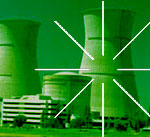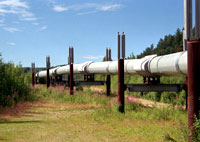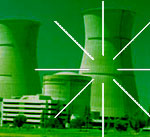America’s fragile domestic infrastructure threatens her energy security at least as much as dependence on oil from the Middle East. Replacing oil from that region with even more vulnerable domestic systems would therefore decrease energy security.

Stranger than science fiction.
Extraordinarily concentrated energy flows invite and reward devastating attack. In our 1982 Pentagon study Brittle Power: Energy Strategy for National Security, we found that a handful of people could shut down three-quarters of the oil and gas supplies to the Eastern states (without leaving Louisiana), cut the power to any major city, or kill millions by crashing an airplane into a nuclear power plant. All of that remains true today. Expanding such centralized and vulnerable energy systems would threaten our national security.
Fundamentally, energy security is less about foreign vs. domestic sources, or a shortage of giant energy facilities, than about the basic architecture of the energy infrastructure. A system is secure not because it’s American or big, but because it’s designed to make large-scale failures impossible and local failures benign. Energy security starts with using less energy far more efficiently to do the same tasks. Then it gets that energy from sources that are inherently invulnerable because they’re dispersed, diverse, and increasingly renewable.
This strategy doesn’t cost more; indeed, it’s already winning in the marketplace. For example, central power stations, no matter how well engineered, can’t supply really cheap and reliable electricity. The power lines that deliver the electricity cost more than the generators, and cause almost all power failures. Onsite and neighborhood micropower is cheaper, eliminates grid losses and glitches, and harnesses waste heat — so savvy investors favor it.
Fuels Paradise
Of course, oil from the Middle East is a problem. Getting oil from the unstable Persian Gulf leaves America less secure and yoked to unattractive regimes. Although only 22 percent of oil imports come from the Gulf (three-fifths come from the Western Hemisphere), decreasing that dependence is wise. But this requires investing in the fastest and cheapest energy system, so we buy the most solution with every year and every dollar spent. We don’t need just another crude-oil source, but an inherently secure supply chain delivering fuel safely all the way to the customer.
Energy efficiency is the rapid-deployment energy resource. Compared to 1975, America used 40 percent less energy and 49 percent less oil last year to produce each dollar of gross domestic product. Those savings are now the nation’s largest “source” of energy — five times domestic oil output. Most were achieved in just six years, from 1979 to 1985, when GDP grew 16 percent, total oil use fell 15 percent, and Gulf imports fell 87 percent. Maintaining that pace could have eliminated all Gulf imports after 1985.
Modern efficiency technologies can put another $300 billion a year back in Americans’ pockets. A light-vehicle fleet that was just 2.7 miles per gallon more efficient would eliminate Gulf imports. Saving energy is the fastest way to blunt OPEC’s market power, beat down prices, and expand the share of energy supply from invulnerable sources. And national security would benefit from improvements in fuel-efficiency in another respect: The Defense Science Board, an influential advisor to the Defense secretary, recently identified billions of dollars of military fuel-saving opportunities.
Then there are new ways to supply fuel that are secure, fast, and competitive. Done right, abundant farm, forest, and even urban wastes can yield clean liquid fuels while protecting topsoil, farmers, rural culture, climate, and prosperity. Producing such biofuels locally bypasses vulnerable pipelines and provides more jobs. Another attractive innovation is fuel cells that use natural gas or renewable energy. (Manhattan’s Conde-Nast Building outperformed its rivals by saving half its energy and incorporating the two most reliable known power sources — fuel cells and solar cells — all at no extra cost.) Together, these proven alternatives can displace oil promptly, securely, profitably — and, in time, completely.
The 800-mile-long Chapstik
In contrast, such options as drilling for oil and gas in the Arctic National Wildlife Refuge decrease security. If the refuge held economically recoverable oil (unlikely and in any case a decade away, according to the official data), then delivering that oil by its only route, the Trans-Alaskan Pipeline System, would undercut the anti-terrorist goals of the Defense Authorization Act. It would make the pipeline the fattest energy-terrorist target in the country — akin, writes Bill McKibben, to pinning a “Kick Me” sign on Uncle Sam’s backside.

In the pipeline of fire.
Photo: NREL.
The pipeline would carry a domestic energy source all right, but it’s frighteningly insecure. It’s mostly aboveground, accessible to attackers, and can become impossible to repair in winter. If pumping stations or key facilities at either end were disabled, 9 million barrels of hot oil could congeal in one winter week into an 800-mile-long Chapstik. The Army, U.S. General Accounting Office, and Senate Judiciary Committee found the pipeline indefensible. On Oct. 4, a drunk shut it down for 60 hours with one rifle shot. It had previously been sabotaged, shot at on over 50 occasions, and incompetently bombed twice. A disgruntled engineer’s more sophisticated plot to blow up three critical points with 14 bombs, then profit from oil futures trading, was thwarted by luck two years ago. He was an amiable bungler compared with the Sept. 11 attackers, whose Algerian colleagues have just threatened to blow up a major gas pipeline to Southern Europe. On the weekend of Oct. 26, Midwest police detained, and later released, six suspicious Middle Eastern men who had photographs of the pipeline.
Both Gulf oil and the vulnerable, rapidly aging Trans-Alaska Pipeline imperil national energy security. Both should be replaced with faster, cheaper, inherently secure energy efficiency and a distributed domestic supply system. That is how to design an energy system that terrorists can’t shut off — and a durable foundation for an America that would no longer be a fragile power.
For further details, please visit the Rocky Mountain Institute’s library of articles on energy and energy security. An earlier version of this piece was published on TomPaine.com.




